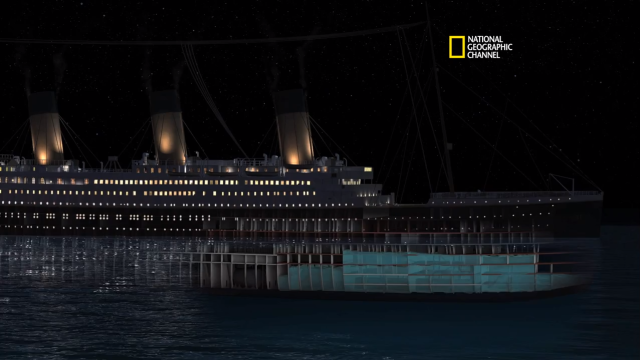100 years ago today, the Titanic sank. Obviously we know the iceberg was the cause, but what exactly did the iceberg damage that caused the ship to snap in half and fall to the bottom of the Atlantic Ocean? Turns out, where the ship was hit proved just as important as the fact that it suffered a blow at all.
The CGI video put together by James Cameron and National Geographic is probably the best, most succinct explanation of the Titanic’s demise to date. But there are many good explanations and theories as to why and how it sank the way it did. And all of those ideas don’t always agree. So let’s explore.
Here’s the short version: The Titanic, upon encountering the iceberg, attempted to steer around the massive block of ice. But in doing so, the side of the Titanic scraped up against the iceberg — which was much more massive underwater than above water — ripping open a hole towards the front of the ship. Attempting to sail on, the ship filled full of water, causing the bow to dip down into the water. Discovery’s recap of the last moments best sum up the tragedy:
At 2:15am the water had already reached the level of the first funnel. Rumbling, crackling and roaring noises followed. The lighting on board flickered and finally went out. The stern tilted up to a 45 degree angle. The critical load at a point between the third and fourth funnels had been reached and the ship split apart down the middle under its enormous weight.
The larger part reared up again by 75 metres and then the ship that had been considered unsinkable went down, bow first. Although a few hundred places were theoretically still vacant, the people in the lifeboats rowed away from those in the water crying for help for fear that their boat would capsize if too many people tried to climb on board. Only lifeboat number four turned round and picked up five people floating in the water, two of whom died in the lifeboat.
Now for some finer points. According to Rough Guides’ Greg Ward (who also maintains a pretty comprehensive Titanic blog), that the Titanic struck an iceberg was not the issue. Rather, it was the fact that the captain tried to steer around the iceberg in the worst possible way: he order the engines to be put in reverse, which essentially threw the ship into a skid. Combine that with the possibility that the hullsman was briefly steering the wrong way, and you have a ship whose side is scraping the iceberg. What makes the incident even more baffling is that the ship would probably have been fine had it hit the iceberg head on.
Reuters, citing author Louise Patten, also puts forth the claim that the ship was steered in the wrong direction and by the time anyone realised, it was too late. But at the urging of the chairman of the White Star Line — which owned the Titanic — the captain had the ship attempt to keep sailing, which only made it sink faster (presumably because the lower compartments were taking on water at a faster rate). Had the ship stopped immediately, it likely would not have sank until everyone was rescued.
Other theorists have put forth the theory that the Titanic sank because of faulty rivets, which let more water into the hull than expected. But US News’ Justin Ewers says that the rivets would not have saved the ship, but only kept it alive for longer than the few hours the Titanic stayed afloat.
Perhaps the most controversial view of them all is that the Titanic did not break into two pieces as nearly everyone suggests, but three. Why is that important? Well it leads some experts, such as Brad Matsen, to the conclusion that the Titanic was poorly constructed and that its flimsy hull was in no way equipped to handle such an incident.
Whether or not it was because of faulty materials, or human error, or simply fate, the Titanic is still a disaster that resonates with society 100 years later as a reminder that even the grandest and most indestructable of technological feats are still at the mercy of nature.
